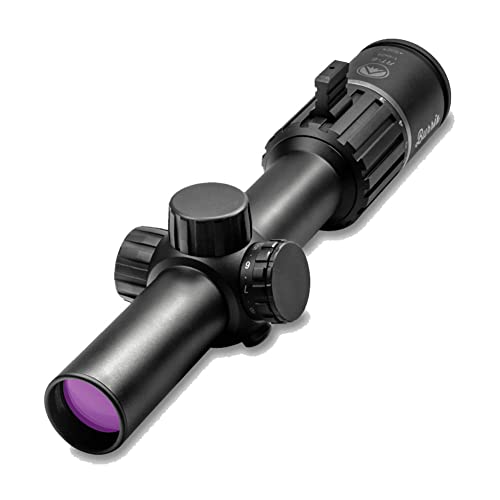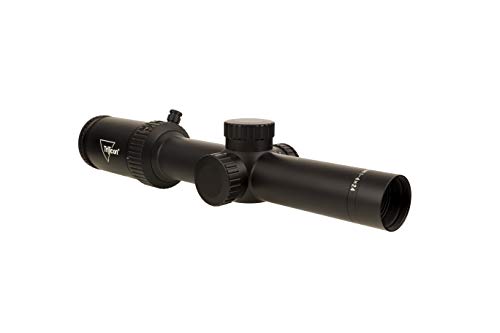In the dynamic world of modern shooting, versatility is king. Whether you’re navigating a 3-Gun course, hunting in dense timber, or preparing a rifle for home defense, a Low Power Variable Optic (LPVO) offers the ideal blend of close-quarters speed and mid-range precision. The ability to transition from a true 1x magnification for rapid target acquisition to a higher power for precise shot placement makes the LPVO an indispensable tool for the prepared shooter.
With so many options on the market, selecting the right scope can be a challenge. The best LPVO for you depends on your specific needs, platform, and budget. This roundup for 2025 cuts through the noise to present eight of the top-performing LPVO scopes available, highlighting their key features and benefits to help you make an informed decision for your next upgrade.
Our Top Picks for LPVO Scopes
- Vortex Optics Strike Eagle 1-8×24 SFP Riflescope
- BURRIS 1-6x24mm RT6 Scope, Illum. Ballistic
- Sightmark Citadel Second Focal Plane Riflescope
- Vortex Optics Viper PST Gen II SFP Riflescopes
- Trijicon Credo HX Illuminated Hunting Riflescopes
- Vortex Optics Strike Eagle 1-8×24 SFP Riflescope
- Primary Arms SLx 1-6x24mm SFP Rifle Scope
- Sig Sauer TANGO-MSR 1-10x28mm FFP Riflescope
Vortex Optics Strike Eagle 1-8×24 Second Focal Plane Riflescope

The updated Vortex Strike Eagle 1-8×24 is built for speed and adaptability. Its true 1x magnification on the low end allows for fast, both-eyes-open shooting, making it highly effective for close-quarters scenarios. When you need to reach out, the 8x top end provides the clarity for more precise shots at extended ranges.
This model includes several user-focused improvements. The magnification ring has been updated and now features a thread-in throw lever for quick magnification changes. The new illuminated BDC3 reticle is designed for faster target acquisition and includes holdover points for immediate use on targets out to 650 yards, assuming a known distance.
BURRIS 1-6x24mm RT6 Scope

The Burris RT6 has earned a stellar reputation as a top-tier value in the 1-6x LPVO category. Its true 1x setting provides a wide, unobstructed field of view that is critical for fast, dynamic shooting. The 6x magnification is sufficient for most engagements within the effective range of common rifle cartridges.
This scope is known for its bright and crisp illuminated ballistic reticle, which offers a clean sight picture at any magnification setting. The robust construction and reliable performance of the RT6 make it a trusted choice for competitive shooters and recreational marksmen who demand quality without an excessive cost.
Sightmark Citadel Second Focal Plane Riflescope

The Sightmark Citadel series offers a modern feature set designed for the tactical and hunting shooter. These scopes are built to handle recoil and harsh environmental conditions, providing a reliable optic for demanding use. The second focal plane design ensures the reticle remains the same size at all magnification levels.
With an illuminated reticle and a magnification range that bridges close and medium-range shooting, the Citadel is a versatile optic. It represents an accessible entry point into the LPVO market for shooters who need dependable performance and modern features on a sensible budget.
Vortex Optics Viper PST Gen II Second Focal Plane Riflescopes

Sitting above the Strike Eagle in Vortex’s lineup, the Viper PST Gen II is a premium offering for serious shooters. It features high-quality, fully multi-coated lenses that deliver exceptional light transmission and clarity from dawn until dusk. The rugged one-piece chassis is built to withstand heavy recoil and rough handling.
This scope includes professional-grade features like a precision-force spring system for smooth magnification adjustments and a highly visible illumination control system. The Viper PST Gen II is designed for those who require uncompromising optical performance and durability in a tactical or precision hunting environment.
Trijicon Credo HX Illuminated Hunting Riflescopes

Trijicon is synonymous with durability and reliability, and the Credo HX series continues that legacy. These scopes are engineered with high-density, extra-low dispersion glass that provides outstanding resolution and color fidelity. The result is a bright, sharp image that gives you an advantage in low-light conditions.
The Credo HX features an illuminated reticle with Trijicon’s legendary battery-free LED or fiber-optic/tritium illumination options on certain models. Built to survive extreme conditions and maintain zero under heavy recoil, this is a top-shelf optic for hunters and shooters who will not accept compromise on quality.
Vortex Optics Strike Eagle 1-8×24 Second Focal Plane Riflescope
As a repeat entry in our list, the Vortex Strike Eagle 1-8×24 deserves attention for its specific configuration and widespread popularity. This model provides that critical extra magnification over a standard 1-6x scope, giving you more versatility for target identification and precise shot placement at longer distances without sacrificing close-range speed.
The inclusion of a throw lever out of the box is a significant benefit, allowing you to quickly crank the magnification from 1x to 8x in an instant. Backed by Vortex’s unbeatable VIP warranty, this scope offers tremendous peace of mind and value for a wide range of shooting applications.
Primary Arms SLx 1-6x24mm SFP Rifle Scope with ACSS Raptor Reticle
Primary Arms has revolutionized the optics market with its innovative ACSS reticle system. The SLx 1-6x24mm model features the ACSS Raptor reticle, which is designed for rapid close-range shooting while also providing holdovers for moving targets and ranging capabilities. This makes it an exceptionally intuitive and practical optic.
Built with durability in mind, the SLx series offers reliable performance at an accessible price point. The combination of a robust construction and a highly functional, etched-glass reticle makes this scope a favorite among shooters who appreciate a reticle that does more than just provide an aiming point.
Sig Sauer TANGO-MSR 1-10x28mm FFP Riflescope
The Sig Sauer TANGO-MSR 1-10x28mm pushes the boundaries of LPVO versatility with its impressive magnification range. As a First Focal Plane (FFP) optic, the reticle grows and shrinks with the magnification, meaning the holdover points remain accurate at any power setting. This is a significant advantage for precision shooting at unknown distances.
With a true 1x on the low end and a massive 10x on the high end, this scope functions like a red dot at close range and a dedicated mid-range optic at full magnification. The large 28mm objective lens helps gather more light, contributing to a bright and clear sight picture across the entire magnification range.
What to Look For in an LPVO Scope
Choosing the right Low Power Variable Optic can feel like a big task with so many options out there. I’ve spent a lot of time behind these scopes, and I can tell you that focusing on a few key areas will make your decision much easier. It’s not just about picking the one with the highest magnification; it’s about how the scope fits your specific needs.
First, think about the magnification range. The classic 1-6x or 1-8x are incredibly popular for a reason. They offer a true 1x setting that lets you shoot with both eyes open like a red dot for close-quarters, while still giving you enough power to reach out to several hundred yards. If you’re mostly shooting at shorter distances, a 1-4x might be perfect and is often lighter. For those who need a bit more precision, newer 1-10x models are amazing, but they come with a higher price tag and are often heavier.
Next up is the reticle. This is your interface with the target, so it’s a personal choice. I prefer an illuminated reticle for fast shooting in low light. The key is to find one that isn’t too busy at 1x but still gives you useful holdovers at max magnification. Second Focal Plane (SFP) reticles are common and keep the reticle size constant, which is simple. First Focal Plane (FFP) reticles change size as you zoom, so your holdover marks are always accurate at any magnification. FFP is fantastic for long-range shooting, but on a 1-6x scope, the reticle can get very small at 1x power.
Finally, don’t ignore the build quality and glass clarity. You need a scope that can handle recoil and the occasional bump. Look for scopes that are purged with nitrogen or argon to prevent fogging and are made from a single piece of aircraft-grade aluminum. The quality of the glass makes a huge difference in low-light performance. Better coatings mean brighter, sharper images. It’s an area where you often get what you pay for. A clear, bright sight picture is what makes these 8 Best LPVO Scopes (Low Power Variable Optics) in 2025 so effective.
FAQ
What does LPVO stand for?
LPVO stands for Low Power Variable Optic. It’s a type of riflescope that starts at a low magnification, typically 1x, and zooms to a higher power, like 6x, 8x, or even 10x. The 1x setting lets you use it like a red dot sight for fast, close-range shooting, while the higher magnifications allow for more precise shots at longer distances.
Is a 1-6x LPVO good for an AR-15?
Absolutely. A 1-6x LPVO is arguably the most versatile optic you can put on a standard AR-15. It’s my go-to recommendation for a general-purpose rifle. It gives you the speed you need for home defense or close-range drills and enough magnification to effectively engage targets out to 500 yards or so, making it a true do-it-all sight for that platform.
What is the difference between FFP and SFP in an LPVO?
This is a big one. In a Second Focal Plane (SFP) scope, the reticle size stays the same as you zoom. The hash marks for bullet drop are only accurate at one magnification, usually the highest setting. In a First Focal Plane (FFP) scope, the reticle grows and shrinks as you change magnification. This means the holdover marks are correct at any power. For most LPVO uses, SFP is perfectly fine, but if you plan on doing precision shooting at mid-range magnifications, FFP is the way to go.
Do I need an illuminated reticle?
While not strictly necessary, I highly recommend an illuminated reticle on an LPVO. The whole point of the 1x setting is speed, and a bright, illuminated center dot or circle makes acquiring targets against dark or complex backgrounds much faster. It turns your scope into a viable option in low-light conditions. For a dedicated daytime competition or hunting scope, you might skip it, but for a defensive or all-around rifle, illumination is a huge benefit.
How much should I expect to spend on a good LPVO?
You can find entry-level LPVO scopes for around $200 to $500, and they can be surprisingly decent. However, when you move into the $500 to $1,500 range, you see a significant jump in glass quality, durability, and features like daylight-bright illumination. The top-tier models from brands like Nightforce and Tangent Theta can exceed $3,000. When considering the 8 Best LPVO Scopes (Low Power Variable Optics) in 2025, you’ll find options across this entire spectrum to fit different budgets.
Can I use an LPVO for hunting?
Yes, an LPVO is an excellent choice for many types of hunting. In thick woods where shots are close and fast, the 1x setting is perfect. If you spot a deer across a field, you can quickly zoom to 6x or 8x for a more precise shot. It’s a very flexible system for hunters who encounter varying terrains and shot distances, making it a great alternative to traditional fixed-power scopes.